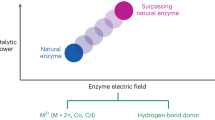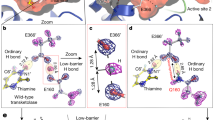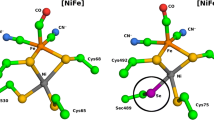Abstract
Biological catalysts (enzymes) speed up reactions by many orders of magnitude using fundamental physical processes to increase chemical reactivity. Hydrogen tunnelling has increasingly been found to contribute to enzyme reactions at room temperature1. Tunnelling is the phenomenon by which a particle transfers through a reaction barrier as a result of its wave-like property1,2,3. In reactions involving small molecules, the relative importance of tunnelling increases as the temperature is reduced4. We have now investigated whether hydrogen tunnelling occurs at elevated temperatures in a biological system that functions physiologically under such conditions. Using a thermophilic alcohol dehydrogenase (ADH), we find that hydrogen tunnelling makes a significant contribution at 65 °C; this is analogous to previous findings with mesophilic ADH at 25 °C ( ref. 5). Contrary to predictions for tunnelling through a rigid barrier, the tunnelling with the thermophilic ADH decreases at and below room temperature. These findings provide experimental evidence for a role of thermally excited enzyme fluctuations in modulating enzyme-catalysed bond cleavage.
This is a preview of subscription content, access via your institution
Access options
Subscribe to this journal
Receive 51 print issues and online access
$199.00 per year
only $3.90 per issue
Buy this article
- Purchase on Springer Link
- Instant access to full article PDF
Prices may be subject to local taxes which are calculated during checkout




Similar content being viewed by others
References
Kohen, A. & Klinman, P. J. Enzyme catalysis: beyond classical paradigms. Acc. Chem. Res. 31, 397– 404 (1998).
Bell, R. P. The Tunneling Effect in Chemistry (Chapman & Hall, London, (1980).
Steinfeld, J. I., Francisco, J. S. & Hase, W. L. (eds) Chemical Kinetics and Dynamics (Prentice Hall, Upper Saddle River, NJ, (1998).
Benderskii, V. A., Makarov, D. E. & Wight, C. A. Adv. Chem. Phys. 88, 151– 207 (1994).
Cha, Y., Murray, C. J. & Klinman, J. P. Hydrogen tunneling in enzyme reactions. Science 243, 1325–1330 ( 1989).
Brooks, C. L. I., Karplus, M. & Pettitt, B. M. Adv. Chem. Phys. 71, 14– 23; 33–59; 75–233 ; (1988).
Rasmussen, B. F., Stock, A. M., Ringe, D. & Petsko, G. A. Crystalline ribonuclease-A loses function below the dynamical transition at 220-K. Nature 357, 423–424 ( 1992).
Rudd, P. M.et al. Glycoforms modify the dynamic stability and functional activity of an enzyme. Biochemistry 33, 17–22 (1994).
Kohen, A., Jonsson, T. & Klinman, P. J. Effect of protein glycosylation on catalysis: changes in hydrogen tunneling and enthalpy of activation in the glucose oxidase reaction. Biochemistry 36, 2603– 2611 (1997).
Cannio, R., Rossi, M. & Bartolucci, S. Afew amino acid substitutions are responsible for the higher thermostability of a novel NAD(+)-dependent bacillar alcohol dehydrogenase. Eur. J. Biochem. 22, 345– 352 (1994).
Guagliardi, A.et al. Purification and characterization of the alcohol dehydrogenase from a novel strain of bacillus stearothermophilus growing at 70 °C. Int. J. Biochem. Cell Biol. 28, 239– 246 (1996).
Lakatos, S., Halasz, G. & Zavodszky, P. Conformational stability of lactate dehydrogenase from Bacillus thermus-aquaticus. Biochem. Soc. Trans. 6, 1195–1197 (1978).
Zavodszky, P., Kardos, J., Svingor, A. & Petsko, G. A. Adjustment of conformational flexibility is a key event in the thermal adaptation of protein. Proc. Natl Acad. Sci. USA 95, 7406– 7411 (1998).
Varley, P. G. & Pain, R. H. Relation between stability, dynamics and enzyme activity in 3-phosphoglycerate kinases from yeast and Thermus thermophilus. J. Mol. Biol. 220, 531– 538 (1991).
Wrba, A., Schweiger, A., Schultes, V., Jaenicke, R. & Zavodszky, P. Extremely thermostable D-glyceraldehyde-3-phosphate dehydrogenase from the eubacterium Thermotoga maritima. Biochemistry 29, 7584–7592 ( 1990).
Lin, S. & Saunders, W. H. Tunneling in elimination reactions—structural effects on the secondary beta-tritium isotope effects. J. Am. Chem. Soc. 116, 6107–6110 ( 1994).
Saunders, W. H. Calculations of isotope effects in elimination reactions. New experimental criteria for tunneling in slow proton transfers. J. Am. Chem. Soc. 107, 164–169 ( 1985).
Rucker, J. & Klinman, J. P. Computational study of tunneling and coupled motion. J. Am. Chem. Soc. 121, 1997–2006 (1999).
Melander, L. & Saunders, W. H. Reaction Rates of Isotopic Molecules (Krieger, Malabar, FL, (1987).
Vihinen, M. Relationship of protein flexibility to thermostability. Protein Eng. 1, 477–480 ( 1987).
Vol'kenshtein, M. V., Dogonadze, R. R., Madumarov, A. K., Urushadze, Z. D. & Kharkats, Y. I. The theory of enzyme catalysis. Mol. Biol. 6, 347– 353 (1972).
Hwang, J. K. & Warshel, A. On the relationship between the dispersed polaron and spin-boson models. Chem. Phys. Lett. 271, 223–225 (1997).
Antoniou, D. & Schwartz, S. D. Large kinetic isotope effect in enzymatic proton transfer and the role of substrate oscillations. Proc. Natl Acad. Sci. USA 94, 12360– 12365 (1997).
Borgis, D. & Hynes, J. T. in The Enzyme Catalysis Process (eds Cooper, A., Houben, J. & Chien, L.) 293– 303 (Plenum, New York, (1989).
Bruno, W. J. & Bialek, W. Vibrationally enhanced tunneling as a mechanism for enzymatic hydrogen transfer. Biophys. J. 63, 689–699 (1992).
Borgis, D. & Hynes, J. T. Dynamical theory of proton tunneling transfer rates in solution—general formulation. Chem. Phys. 170, 315–346 ( 1993).
Antoniou, D. & Schwartz, S. D. Activated chemistry in the presence of a strongly symmetrically coupled vibration. J. Chem. Phys. 108, 3620–3625 (1998).
Somero, G. N. & Siebenaller, J. F. Inefficient lactate dehydrogenases of deep-sea fishes. Nature 282, 100– 102 (1979).
Acknowledgements
This work was supported by the NSF (A.K. and J.P.K.) and EC-projects (R.C. and S.B.).
Author information
Authors and Affiliations
Corresponding author
Rights and permissions
About this article
Cite this article
Kohen, A., Cannio, R., Bartolucci, S. et al. Enzyme dynamics and hydrogen tunnelling in a thermophilic alcohol dehydrogenase . Nature 399, 496–499 (1999). https://doi.org/10.1038/20981
Received:
Accepted:
Issue Date:
DOI: https://doi.org/10.1038/20981
This article is cited by
-
Quantum tunneling time delay investigation of \({{\varvec{K}}}^{+}\) ion in human telomeric G-quadruplex systems
JBIC Journal of Biological Inorganic Chemistry (2023)
-
Atomically unveiling the structure-activity relationship of biomacromolecule-metal-organic frameworks symbiotic crystal
Nature Communications (2022)
-
A Minireview on Temperature Dependent Protein Conformational Sampling
The Protein Journal (2021)
-
Theoretical study on kinetics of ammonia-catalyzed ground-state tautomerization in 2-pyridone: effect of chemical modification
Chemical Papers (2019)
-
Theoretical study on the substituent effect of halogen atom at different position of 7-azaindole-water derivatives: relative stability and excited-state proton-transfer mechanism
Structural Chemistry (2018)
Comments
By submitting a comment you agree to abide by our Terms and Community Guidelines. If you find something abusive or that does not comply with our terms or guidelines please flag it as inappropriate.



